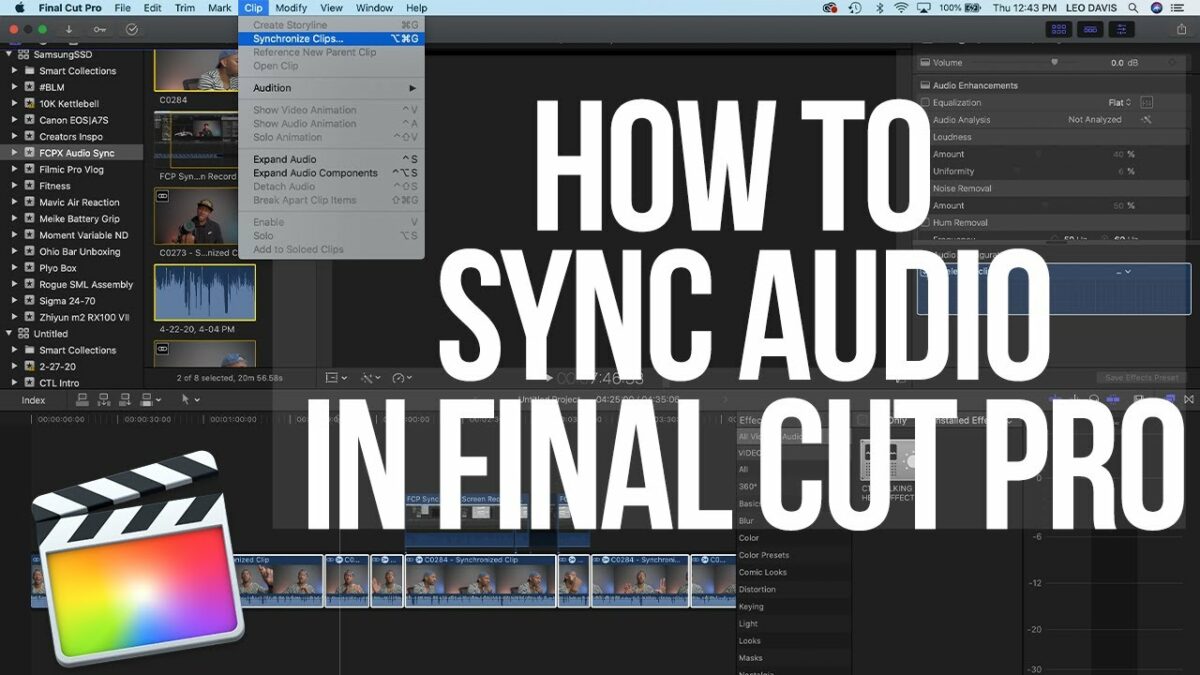Introduction: Syncing audio and video is a fundamental task in video editing, crucial for ensuring seamless playback and a professional-quality viewing experience. Whether you’re working on a film project, a documentary, or a vlog, precise synchronization between audio and video elements is essential for maintaining coherence and narrative flow. Final Cut Pro, a leading video editing software, offers powerful tools and features to streamline the process of syncing audio and video, allowing editors to achieve perfect synchronization with ease. In this comprehensive guide, we’ll explore the intricacies of syncing audio and video in Final Cut Pro, covering techniques, workflows, and expert tips to help you master this essential aspect of video post-production.
Understanding Audio and Video Sync in Final Cut Pro: Audio and video synchronization in Final Cut Pro involves aligning audio tracks with corresponding video clips to ensure that they play back together seamlessly. This process is necessary when working with externally recorded audio, such as separate audio files captured with external microphones or audio recorders, or when editing multicamera footage with separate audio sources. Final Cut Pro provides various methods for syncing audio and video, including manual synchronization, automatic synchronization using audio waveforms, and synchronization based on timecode or markers. By mastering the tools and techniques for syncing audio and video in Final Cut Pro, editors can enhance the quality and professionalism of their video projects.
Step-by-Step Guide to Syncing Audio and Video in Final Cut Pro:
- Import Audio and Video Clips: Start by importing your audio and video clips into Final Cut Pro. Organize your media in the Event Browser and ensure that each audio clip corresponds to the appropriate video clip or scene.
- Identify Sync Points: Before syncing audio and video, identify specific sync points or reference points that are common to both the audio and video tracks. These sync points could include visual cues, such as claps or slate claps, or audible cues, such as loud sounds or dialogue.
- Manual Syncing:
a. Drag and Align: Manually align the audio and video clips in the timeline by dragging them to the desired position. Use the playhead and waveform displays to visually align the audio waveform with corresponding visual cues in the video clip.
b. Fine-Tune Sync: Zoom in on the timeline to fine-tune the synchronization and ensure that the audio and video tracks are perfectly aligned. Use the arrow keys to nudge the audio or video clips frame by frame for precise synchronization.
- Automatic Syncing with Audio Waveforms:
a. Sync Clips Command: Select the audio and video clips you want to sync in the Event Browser or the timeline. Right-click on the selected clips and choose “Synchronize Clips” from the context menu, or use the keyboard shortcut Option + Command + G.
b. Adjust Sync Parameters: In the Synchronize Clips dialog box, adjust the synchronization parameters to specify how Final Cut Pro should analyze and sync the clips. You can choose to synchronize based on audio waveforms, timecode, or markers, depending on the availability of reference points in your footage.
c. Review and Confirm: After syncing, review the synchronized clips in the timeline to ensure that the audio and video tracks are properly aligned. Make any necessary adjustments or corrections to the sync points or parameters if the synchronization is not accurate.
- Syncing with Timecode or Markers:
a. Timecode Sync: If your audio and video clips have embedded timecode information, Final Cut Pro can automatically synchronize them based on their timecode values. Select the clips in the Event Browser or timeline, then choose “Synchronize Clips” and select “Timecode” as the synchronization method.
b. Marker Sync: Alternatively, you can use markers as reference points to synchronize audio and video clips. Place markers at corresponding points in the audio and video tracks, then select the clips and choose “Synchronize Clips” and select “Markers” as the synchronization method.
- Adjust and Fine-Tune:
a. Check Sync Accuracy: After syncing, review the synchronized clips in the timeline to ensure that the audio and video tracks are properly aligned. Scrub through the timeline or play the clips to confirm the synchronization accuracy.
b. Fine-Tune if Necessary: If the synchronization is not accurate, make any necessary adjustments or corrections to the sync points or parameters. Use the trim tools, nudging, or re-syncing options to refine the synchronization and achieve perfect alignment.
- Apply Additional Edits and Effects:
a. Trim and Edit: Once the audio and video clips are properly synced, you can proceed with additional editing tasks, such as trimming, cutting, or rearranging clips in the timeline to refine the sequence and pacing of your video project.
b. Apply Effects and Enhancements: Add effects, transitions, color corrections, and audio enhancements to further enhance the visual and auditory quality of your video project. Experiment with different effects and adjustments to achieve the desired look and feel.
- Preview and Playback:
a. Preview Playback: Preview the synced audio and video clips in the timeline to assess the synchronization accuracy and overall quality of the footage. Use the playback controls to scrub through the timeline or play the clips to evaluate the synchronization in real time.
b. Fine-Tune as Needed: If you notice any discrepancies or issues with the synchronization, go back and fine-tune the sync points or parameters to achieve the desired result. Pay attention to visual and auditory cues to ensure that the audio and video tracks remain perfectly aligned.
- Render and Export:
a. Render Process: Once you’re satisfied with the synchronization and editing of your video project, render the final timeline to prepare it for export. Go to the “File” menu, select “Share,” and choose the desired output format and settings for your video.
b. Export Settings: Configure the export settings, such as resolution, frame rate, and compression settings, to meet the requirements of your delivery platform or distribution channels. Choose a destination folder and filename for your exported video, then click “Export” to start the rendering process.
Tips and Best Practices for Syncing Audio and Video in Final Cut Pro:
- Use High-Quality Reference Points: When syncing audio and video manually, choose clear and distinct reference points that are easy to identify and align. Look for visual or audible cues that stand out and provide reliable synchronization markers.
- Verify Sync Accuracy: Always double-check the synchronization accuracy after applying automatic syncing methods in Final Cut Pro. Scrub through the timeline or play the synced clips to ensure that the audio and video tracks are properly aligned and synced.
- Adjust Sync Parameters as Needed: When using automatic syncing methods, experiment with different synchronization parameters and options to achieve the best results. Adjust settings such as sync method, tolerance, and reference points to optimize synchronization accuracy.
- Consider Audio Latency: Be mindful of audio latency or delay when syncing externally recorded audio with video footage in Final Cut Pro. Adjust the sync points or parameters to compensate for any latency issues and ensure that the audio and video tracks remain perfectly aligned.
- Organize and Label Clips: Keep your media organized and labeled in Final Cut Pro to facilitate the syncing process and streamline your workflow. Use descriptive filenames, keywords, and metadata to identify audio and video clips and ensure that they are paired correctly.
- Use Multicam Syncing for Multicam Footage: When working with multicamera footage in Final Cut Pro, use the multicam syncing feature to automatically synchronize multiple video and audio tracks based on common reference points. This can save time and effort compared to manual syncing methods.
- Experiment with Different Techniques: Explore different syncing techniques and workflows in Final Cut Pro to find the method that works best for your specific project and workflow. Experiment with manual syncing, automatic syncing, and combination methods to achieve optimal synchronization results.
- Backup Original Files: Before making any changes or modifications to your audio and video clips in Final Cut Pro, always make backup copies of the original files. This ensures that you can revert to the original footage if needed and prevents data loss or corruption.
- Seek Assistance and Collaboration: Don’t hesitate to seek assistance or collaborate with colleagues, friends, or online communities when syncing audio and video in Final Cut Pro. Share your challenges, questions, and insights to gather feedback and support from fellow editors and filmmakers.
Conclusion: Syncing audio and video in Final Cut Pro is a fundamental task in video editing, essential for ensuring seamless playback and a professional-quality viewing experience. By following the steps outlined in this comprehensive guide and embracing best practices, you’ll be well-equipped to master the art of syncing audio and video in Final Cut Pro. So, dive in, experiment fearlessly, and let your creativity shine as you achieve perfect synchronization and elevate the quality and professionalism of your video projects.


